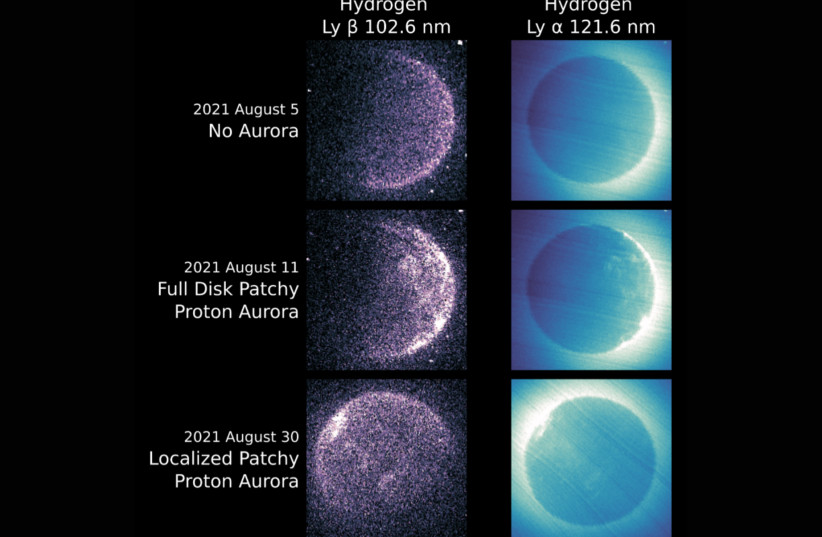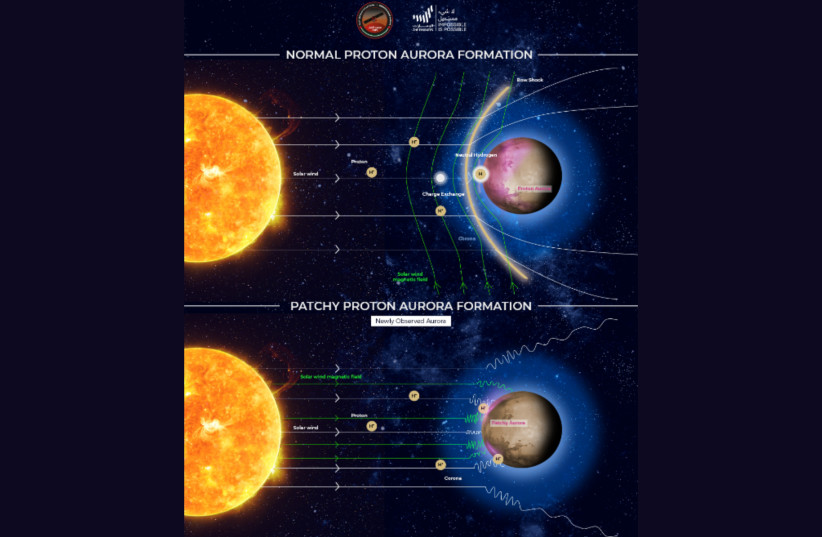The United Arab Emirate's Mars Mission (EMM) and NASA's Mars Atmosphere and Volatile Evolution (MAVEN) mission have found "patchy" proton auroras in Mars' skies, bringing new insights into the red planet's atmosphere.
The findings were published in the peer-reviewed journal Geophysical Research Letters on Wednesday.
Proton auroras are a type of Martian aurora (similar to the phenomenon that causes the Northern Lights) that form as solar wind, made up of charged particles from the Sun, interacts with the planet's upper atmosphere.
Earlier observations by MAVEN and the European Space Agency's Mars Express mission had shown these aurorae appear smooth and evenly distributed, but the Emirati mission's observations showed the aurora appearing highly dynamic and variable.
The discovery was made using EMM's global aurora images with MAVEN's simultaneous local plasma observations after NASA and the UAE signed a data-sharing agreement.

The new type of aurora is formed with the solar wind hitting Mars' dayside upper atmosphere and emits ultraviolet light as it slows down. The Emirates Mars Ultraviolet Spectrometer caught the phenomenon in snapshots of the dayside disk.
“Our discovery of these patchy proton aurora adds a new kind of event to the long list of those currently studied by EMM and challenges our existing views of how the proton aurora on Mars’ dayside are formed,” said Hessa Al Matroushi, EMM’s Science Lead.
“The EMM Hope probe has so far uncovered many unexpected phenomena that extend our understanding of Mars’ atmospheric and magnetospheric dynamics. These new observations, combined with MAVEN data, have lifted the lid on entirely new possibilities for scientific research.”

“EMM’s observations suggested that the aurora was so widespread and disorganized that the plasma environment around Mars must have been truly disturbed, to the point that the solar wind was directly impacting the upper atmosphere wherever we observed auroral emission,” said Mike Chaffin, a MAVEN and EMM scientist based at the Laboratory for Atmospheric and Space Physics at the University of Colorado Boulder and lead author of the study.
“By combining EMM auroral observations with MAVEN measurements of the auroral plasma environment, we can confirm this hypothesis and determine that what we were seeing was essentially a map of where the solar wind was raining down onto the planet,” he added.
Chaffin added that the conditions that create the patchy aurora are a rare circumstance and the full impact of the unusually chaotic Mars-solar wind interaction is unknown. The EMM and MAVEN observations will serve a key role in understanding these conditions.
“EMM’s global observations of the upper atmosphere provide a unique perspective on a region critical to MAVEN science," stressed MAVEN Principal Investigator Shannon Curry, of UC Berkeley’s Space Sciences Laboratory.
“These types of simultaneous observations probe the fundamental physics of atmospheric dynamics and evolution and highlight the benefits of international scientific collaboration,” she added.
Matroushi added that “access to MAVEN data has been essential for placing these new observations into a wider context. Together, we’re pushing the boundaries of our existing knowledge not only of Mars, but of planetary interactions with the solar wind."
UAE Hope Probe made the country the fifth space agency to reach the red planet
The UAE's Hope Probe entered orbit around Mars in February of last year, making the Emirates the fifth space agency to reach the red planet and the farthest an Arab country's space program has reached.
The Emirates Mars Mission, which cost around $200 million, launched the Hope Probe from a Japanese space center. It aims to provide a complete picture of the Martian atmosphere for the first time, studying daily and seasonal changes.
In October of last year, Israel and the UAE signed a historic space exploration and cooperation agreement at ‘World Space Week’, part of the 2020 Expo Dubai.
Reuters contributed to this report.
